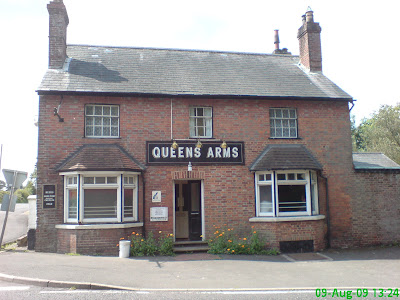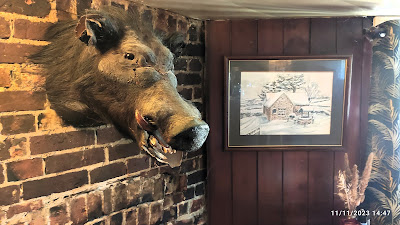The
Boar’s Head Inn at
Eridge, is an unspoilt
17th Century
inn, just off the main
A26 road, a mile or so to the north of
Crowborough. It is
a low beamed pub with a cosy interior, featuring two inglenook fireplaces. There
is outside seating with good views, although when I called in on
Saturday, it
wasn’t exactly a day for sitting outside. For those who are hardier than me, it’s
worth noting, that to the north of the pub, there is a steep wide valley that
is traversed by the
A26, where twin streams flow along a valley floor flanked
by thickly wooded slopes. The railway between
Ashurst and
Crowborough makes
its way along this valley before journeying to the end of the line at
Uckfield.
So, what was I doing at the Boar’s Head? A pub I’d last visited
over 30 years ago, and one that I got to know just a few years after moving to
Tonbridge. It was my involvement with the local CAMRA branch, which was then
known as Tonbridge & Tunbridge Wells CAMRA that took me to the Boar’s Head,
as back then the branch covered a small area of neighbouring East Sussex, that
included Crowborough.
I remember the place as an unspoilt old inn that belonged to
Whitbread, and as such served a decent drop of Faversham-brewed,
Fremlin’s
Bitter. A decade or so later, and a change of employer, led to me commuting, by
car, every day between
Tonbridge and
Lewes, so I often drove by on my journey
to and from work. I say
“often” because sometimes I would take the scenic route
across
Ashdown Forest, thereby avoiding the traffic bottlenecks of
Tunbridge Wells and
Crowborough.
I was prompted to make a long overdue visit to the
Boar’s
Head after driving to
Crowborough the day before.
Mrs PBT’s, and I had visited
a medical centre in the town, in order to obtain our
COVID booster vaccinations
, but the
drive through the town is one we take quite often, as
Eileen’s sister, and
niece live in nearby
Uckfield. Despite this
familiarity, I hadn’t given too much notice to the
Boar’s Head as it is now set
back from the main
A26 road. When I worked in
Lewes, work was underway to straighten
and widen what was a notorious stretch of road between
Eridge and
Crowborough, which
is why the pub is now, mercifully separated from the
A26.
The
Boar’s Head is also on the
No. 29 bus route between operated
by
Brighton & Hove Buses, which runs every half-hour on weekdays and
Saturdays, between
Brighton and
Tunbridge Wells. It is a well-used service, and
for those with a bus pass, the ideal way to travel between
Kent and
Sussex.
With a bus stop, virtually outside the pub, it’s an ideal way to visit the
Boar’s
Head, without having to drive. Having clocked the position of the bus stops, on
both sides of the road, as we drove passed on
Friday, the following day I
decided to hop on the bus from
Tunbridge Wells and check out the
Boar’s Head for
myself.
It has to be at least
30 years since I last set foot in the pub,
and I’m pleased to report that very little had changed. Arriving shortly after
2 pm, I found the pub pleasantly busy, without being overcrowded. Here were
several groups of diners, but also a group of drinkers either propping up the
bar or sitting at it. I joined the latter group, as I had no real plans to eat,
and faced with a choice of
Harvey’s Best or
London Pride, I opted for the former.
It cost me a fiver, which seems to be the going rate for
Harvey’s,
these days. The
Lewes-based company have always been a little on the dear side
when it comes to the prices of their beers, but given their quality, it’s a
price I don’t mind paying.
Harvey’s also became the matter of some debate at
the bar, as two of the fellas sat there were expressing their concerns that the
current cask was unlikely to last the weekend.
According to the two girls behind the bar who, incidentally,
were doing a sterling job, the cask of
Sussex Best on sale was the
LAST ONE. From
what I could gather, the pub’s licensees were on holiday, and there had been a
mix-up with the order from
Harvey’s. The next delivery was scheduled for
Tuesday, and at the current rate, what was left in the cellar was unlikely to
last until then. One worried drinker questioned how many pints had been sold
since the last cask went on sale. One of the girls estimated at least
twenty,
which begged the question, would the
Harvey’s last out until
Tuesday? As serial
pub explorer, and prolific blogger,
Retired Martin would point out, it’s debates
such as this one which make pubs such interesting places.
It’s all about the detail, even if that often includes the trivial
as well, because at the end of the day whilst such things appear unimportant to
the majority of us, to some they represent almost life and death situations.
So, as
Martin would say, it’s seemingly unimportant incidents like the
Harvey’s
running out, that make pub going so interesting and enjoyable.
Final point, I was unlucky with the bus timings on Saturday,
and after missing one in Tonbridge, right at the start of my journey, the
knock-on effect was narrowly missing the No. 29 bus in Tunbridge Wells, as
well. The return journey was marred by a late running service, so after making
my way to the stop, nearly 10 minutes before the bus was due to arrive, I ended
up waiting an additional 15 minutes before it eventually turned up. It wasn’t raining
or anything, so wasn’t a huge deal, but it was chilly, and certainly cold
enough to remind me that the insulating properties of denim aren’t particularly good!
 The High Brooms Hotel was built back in 1899, and is a substantial three storey
detached brick built property. It stands in a prominent position looking back
down the hill towards the station. I don’t know when the building ceased to be
a hotel, but it must have been quite some time before I first knew it. That was
back in the mid 1980’s, when I worked a short distance away from the pub, and
would sometimes call in for a pint at lunchtimes. It was owned then by Beards
of Lewes. Beards were a pub-owning, former brewery that had ceased brewing in the late
1950’s, supposedly because of a yeast infection, but more likely because their
brewery premises in Star Lane, Lewes were rather cramped and in need of
updating. The company entered into an agreement with Harvey’s,
whereby they would purchase beer from their Lewes neighbours and sell it under
their own name. I distinctly remember drinking Beards Sussex Best Bitter during
the early 80’s, and seeing the same range of bottles which Harvey’s produce
with Beards labels on them.
The High Brooms Hotel was built back in 1899, and is a substantial three storey
detached brick built property. It stands in a prominent position looking back
down the hill towards the station. I don’t know when the building ceased to be
a hotel, but it must have been quite some time before I first knew it. That was
back in the mid 1980’s, when I worked a short distance away from the pub, and
would sometimes call in for a pint at lunchtimes. It was owned then by Beards
of Lewes. Beards were a pub-owning, former brewery that had ceased brewing in the late
1950’s, supposedly because of a yeast infection, but more likely because their
brewery premises in Star Lane, Lewes were rather cramped and in need of
updating. The company entered into an agreement with Harvey’s,
whereby they would purchase beer from their Lewes neighbours and sell it under
their own name. I distinctly remember drinking Beards Sussex Best Bitter during
the early 80’s, and seeing the same range of bottles which Harvey’s produce
with Beards labels on them. I’m not sure exactly when this practice ceased, but during
the mid-1980’s, Beards branched out into wholesaling, and operated out of
premises in nearby Hailsham. This operation was eventually floated off and
became “The Beer Seller”. We all know what happened to them, but Beards
continued to operate their pubs in much the same way as before. Then in 1998, the company sold their 40 or so
pubs to Greene King, in a move which shocked local drinkers. Rumour has it that
it also shocked Harvey’s, who had always been under the impression they would
get “first refusal” on Beards, should the company ever come up for sale!
I’m not sure exactly when this practice ceased, but during
the mid-1980’s, Beards branched out into wholesaling, and operated out of
premises in nearby Hailsham. This operation was eventually floated off and
became “The Beer Seller”. We all know what happened to them, but Beards
continued to operate their pubs in much the same way as before. Then in 1998, the company sold their 40 or so
pubs to Greene King, in a move which shocked local drinkers. Rumour has it that
it also shocked Harvey’s, who had always been under the impression they would
get “first refusal” on Beards, should the company ever come up for sale! Roy retired in
July last year and the pub closed. It did obviously not fit in with Greene
King’s plans for their tied estate so they put the High Brooms Tavern up for
sale. Although the company did leave things open for the building to continue
as a pub, there was a real threat it would be bought by a developer and
converted to alternative use, or even demolished. (The pub occupies quite a
prominent site, just a short hop from the station). A local campaign was set
up, with backing from West Kent CAMRA, to try and save the pub and to try and
get it re-opened. Fortunately local residents Peter Whitaker and his son Greg,
bought the pub in March this year, and then spent the next four months carrying
out an extensive renovation plus a complete refit of this 19th
Century building.
Roy retired in
July last year and the pub closed. It did obviously not fit in with Greene
King’s plans for their tied estate so they put the High Brooms Tavern up for
sale. Although the company did leave things open for the building to continue
as a pub, there was a real threat it would be bought by a developer and
converted to alternative use, or even demolished. (The pub occupies quite a
prominent site, just a short hop from the station). A local campaign was set
up, with backing from West Kent CAMRA, to try and save the pub and to try and
get it re-opened. Fortunately local residents Peter Whitaker and his son Greg,
bought the pub in March this year, and then spent the next four months carrying
out an extensive renovation plus a complete refit of this 19th
Century building. We held a well-attended branch social at the pub, earlier in
the week, and were all impressed with the way the pub has been renovated. We
were also pleased to see the pub well-used by a mainly young clientele, with
the darts and pool area particularly well-patronised. Beer-wise there was
Greene King IPA and Golden Hen on sale, alongside the regular’s old
favourite, Harvey’s Best!
We held a well-attended branch social at the pub, earlier in
the week, and were all impressed with the way the pub has been renovated. We
were also pleased to see the pub well-used by a mainly young clientele, with
the darts and pool area particularly well-patronised. Beer-wise there was
Greene King IPA and Golden Hen on sale, alongside the regular’s old
favourite, Harvey’s Best!






























